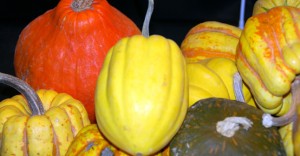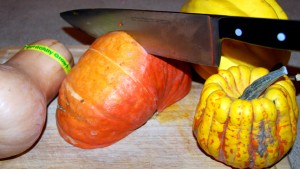

What went through your mind the first time you bought a squash?
It’s sort of like being flashed: What on earth do you imagine I’m going to do with that?
The large, tough-skinned elephant veggies called winter squash differ greatly from European transplants from the Middle East—the zippy little Italian zucchini and large and stalwart British vegetable marrow. Winter squash are more nutritious than the summer varieties, especially in Vitamin A, and have slightly more sugars.
The Latin botanical name for squash is Cucurbita. In Latin, cucurbitare means to commit adultery—and it’s because these members of the melon family are what one historian calls “promiscuous interbreeders” that we have both the name, and also the wide variety of squashes. The varieties are almost too many to name or recognize.
Squash has a long history, and is one of the ancient foods now regaining popularity. Some squashes—mainly the gourds used originally as containers for storage, music-making and masks — originated in Africa, but most of the food squash — including pumpkins — have been found in what anthropologists call Mesoamerica and we call Central America.
When archeologists dig up bones, middens, and human kitchens — e.g. burial sites, firepits and garbage dumps — what they

find, along with teeth, bones, dried poop and other delights, are seeds and various remains of plants, animals, birds and fish. With radio-carbon dating, scientists can put dates on most of these. Biologists add their expertise, and there we have it, a virtual menu of what our long-time human ancestors munched on for dinner. We have fish-hooks from 27,000 years ago, remnants of fire from long before that, and evidence of wild grains being harvested about 17,000 BCE. It was another few years—maybe 7,000—before squashes and pumpkins were domesticated. That makes 10,000 years of squash for supper in our very own continent.
So. What DO you do with it? (Well, I do have some recipes, but I also wanted to say a thing or two about nutrition and food value. You can find those comments here: https://legacy.revelstokecurrent.com//2010/02/01/a-brief-word-about-nutrition-and-food-values)
We started eating squash in my house a few years ago when we went on a low-carb diet. This meant avoiding white food: no white flour products, no potatoes, no white rice, no white spaghetti. I found that cubed and roasted, or boiled and mashed, or in summer when the lovely small zucchini and pattypan squash are fresh from the farm, squash makes a good low-carb alternative to starch. Squash is mild but easily takes on other flavours: butter, mushroom, chilis, lemon, balsamic. It looks pretty on the plate, especially with chicken or fish—lovely shades of orange and yellow, sometimes green. It contains significant amounts of fibre, potassium, Vitamins A and C, and also of folate, a mineral recommended for pregnant women.

Now all you have to do is cook it — after you cut it open that is. Even Mrs. Rombauer in the Joy of Cooking warns you to be careful about this. If baking the squash whole, pierce the skin and flesh with a stiletto — otherwise it may explode in the oven and certainly will mess up your microwave. When cutting up to slice or cube, use a sharp knife, she says, and place the squash on a folded towel. You may have to hammer the knife in with a mallet, so tough is the skin. Once you get the first slice in, the rest is easy. So — why promiscuous?
Goes with everything.



